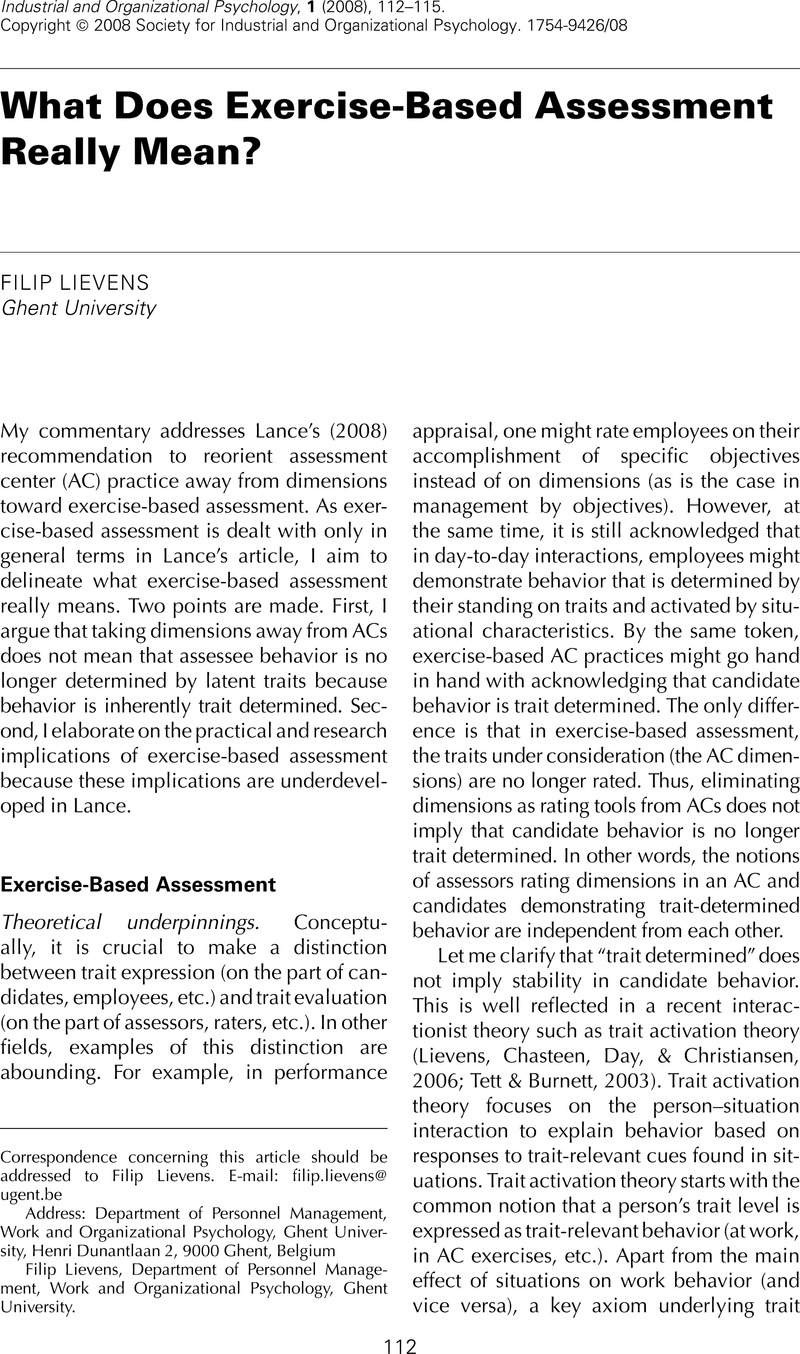Crossref Citations
This article has been cited by the following publications. This list is generated based on data provided by Crossref.
Lance, Charles E.
2008.
Where Have We Been, How Did We Get There, and Where Shall We Go?.
Industrial and Organizational Psychology,
Vol. 1,
Issue. 1,
p.
140.
Lievens, Filip
2009.
Assessment centres: A tale about dimensions, exercises, and dancing bears.
European Journal of Work and Organizational Psychology,
Vol. 18,
Issue. 1,
p.
102.
Streib, Greg
and
Rivera, Mark
2009.
Assessing the Ethical Knowledge of City Managers.
Public Integrity,
Vol. 12,
Issue. 1,
p.
9.
Lievens, Filip
Tett, Robert P.
and
Schleicher, Deidra J.
2009.
Research in Personnel and Human Resources Management.
Vol. 28,
Issue. ,
p.
99.
Blume, Brian D.
Dreher, George F.
and
Baldwin, Timothy T.
2010.
Examining the effects of communication apprehension within assessment centres.
Journal of Occupational and Organizational Psychology,
Vol. 83,
Issue. 3,
p.
663.
Jackson, Duncan J. R.
Stillman, Jennifer A.
and
Englert, Paul
2010.
Task‐Based Assessment Centers: Empirical support for a systems model.
International Journal of Selection and Assessment,
Vol. 18,
Issue. 2,
p.
141.
Huffcutt, Allen I.
2011.
An Empirical Review of the Employment Interview Construct Literature.
International Journal of Selection and Assessment,
Vol. 19,
Issue. 1,
p.
62.
Schollaert, Eveline
and
Lievens, Filip
2011.
The Use of Role-Player Prompts in Assessment Center Exercises.
International Journal of Selection and Assessment,
Vol. 19,
Issue. 2,
p.
190.
HOFFMAN, BRIAN J.
MELCHERS, KLAUS G.
BLAIR, CARRIE A.
KLEINMANN, MARTIN
and
LADD, ROBERT T.
2011.
EXERCISES AND DIMENSIONS ARE THE CURRENCY OF ASSESSMENT CENTERS.
Personnel Psychology,
Vol. 64,
Issue. 2,
p.
351.
Lievens, Filip
and
De Soete, Britt
2012.
The Oxford Handbook of Personnel Assessment and Selection.
p.
383.
Hoffman, Brian J.
and
Meade, Adam
2012.
Alternate Approaches to Understanding the Psychometric Properties of Assessment Centers: An analysis of the structure and equivalence of exercise ratings.
International Journal of Selection and Assessment,
Vol. 20,
Issue. 1,
p.
82.
Monahan, Elizabeth L.
Hoffman, Brian J.
Lance, Charles E.
Jackson, Duncan J. R.
and
Foster, Mark R.
2013.
Now You See Them, Now You Do Not: The Influence of Indicator–Factor Ratio on Support for Assessment Center Dimensions.
Personnel Psychology,
Vol. 66,
Issue. 4,
p.
1009.
Guidry, Brett W.
Rupp, Deborah E.
and
Lanik, Martin
2013.
Simulations for Personnel Selection.
p.
231.
Бородієнко, Олександра
2018.
ВИКОРИСТАННЯ ТЕХНОЛОГІЇ АСЕСМЕНТ-ЦЕНТРІВ ДЛЯ ДІАГНОСТУВАННЯ РІВНІВ РОЗВИНЕНОСТІ ПРОФЕСІЙНОЇ КОМПЕТЕНТНОСТІ КЕРІВНИКІВ СТРУКТУРНИХ ПІДРОЗДІЛІВ ПІДПРИЄМСТВ СФЕРИ ЗВ'ЯЗКУ.
Науковий вісник Інституту професійно-технічної освіти НАПН України. Професійна педагогіка,
p.
61.
Dewberry, Chris
2024.
Assessment centers do not measure competencies: Why this is now beyond reasonable doubt.
Industrial and Organizational Psychology,
Vol. 17,
Issue. 2,
p.
154.



